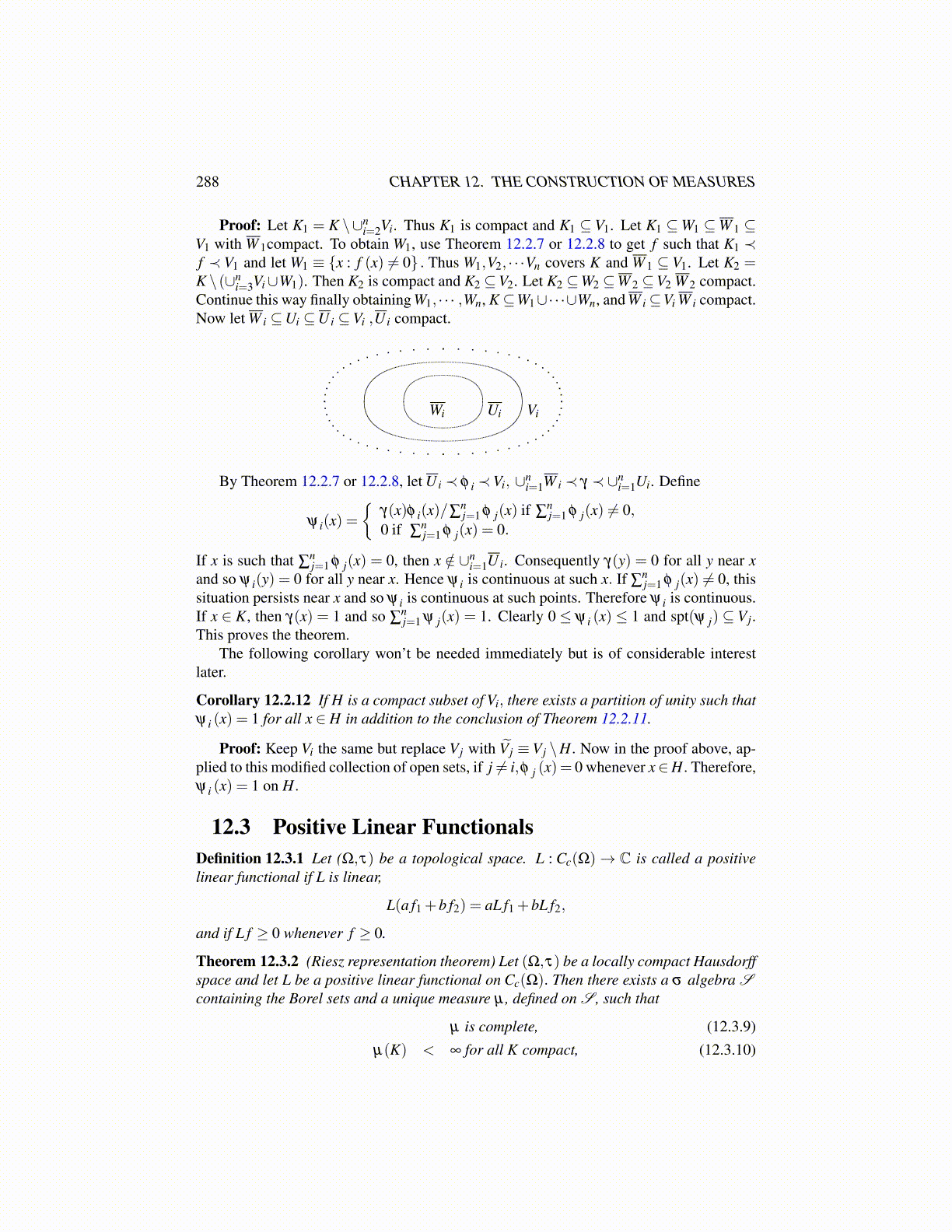
288 CHAPTER 12. THE CONSTRUCTION OF MEASURES
Proof: Let K1 = K \∪ni=2Vi. Thus K1 is compact and K1 ⊆ V1. Let K1 ⊆W1 ⊆W 1 ⊆
V1 with W 1compact. To obtain W1, use Theorem 12.2.7 or 12.2.8 to get f such that K1 ≺f ≺ V1 and let W1 ≡ {x : f (x) ̸= 0} . Thus W1,V2, · · ·Vn covers K and W 1 ⊆ V1. Let K2 =K \ (∪n
i=3Vi∪W1). Then K2 is compact and K2 ⊆V2. Let K2 ⊆W2 ⊆W 2 ⊆V2 W 2 compact.Continue this way finally obtaining W1, · · · ,Wn, K⊆W1∪·· ·∪Wn, and W i⊆Vi W i compact.Now let W i ⊆Ui ⊆U i ⊆Vi ,U i compact.
Wi Ui Vi
By Theorem 12.2.7 or 12.2.8, let U i ≺ φ i ≺Vi, ∪ni=1W i ≺ γ ≺ ∪n
i=1Ui. Define
ψ i(x) ={
γ(x)φ i(x)/∑nj=1 φ j(x) if ∑
nj=1 φ j(x) ̸= 0,
0 if ∑nj=1 φ j(x) = 0.
If x is such that ∑nj=1 φ j(x) = 0, then x /∈ ∪n
i=1U i. Consequently γ(y) = 0 for all y near xand so ψ i(y) = 0 for all y near x. Hence ψ i is continuous at such x. If ∑
nj=1 φ j(x) ̸= 0, this
situation persists near x and so ψ i is continuous at such points. Therefore ψ i is continuous.If x ∈ K, then γ(x) = 1 and so ∑
nj=1 ψ j(x) = 1. Clearly 0 ≤ ψ i (x) ≤ 1 and spt(ψ j) ⊆ Vj.
This proves the theorem.The following corollary won’t be needed immediately but is of considerable interest
later.
Corollary 12.2.12 If H is a compact subset of Vi, there exists a partition of unity such thatψ i (x) = 1 for all x ∈ H in addition to the conclusion of Theorem 12.2.11.
Proof: Keep Vi the same but replace Vj with Ṽj ≡ Vj \H. Now in the proof above, ap-plied to this modified collection of open sets, if j ̸= i,φ j (x) = 0 whenever x∈H. Therefore,ψ i (x) = 1 on H.
12.3 Positive Linear FunctionalsDefinition 12.3.1 Let (Ω,τ) be a topological space. L : Cc(Ω)→ C is called a positivelinear functional if L is linear,
L(a f1 +b f2) = aL f1 +bL f2,
and if L f ≥ 0 whenever f ≥ 0.
Theorem 12.3.2 (Riesz representation theorem) Let (Ω,τ) be a locally compact Hausdorffspace and let L be a positive linear functional on Cc(Ω). Then there exists a σ algebra Scontaining the Borel sets and a unique measure µ , defined on S , such that
µ is complete, (12.3.9)µ(K) < ∞ for all K compact, (12.3.10)